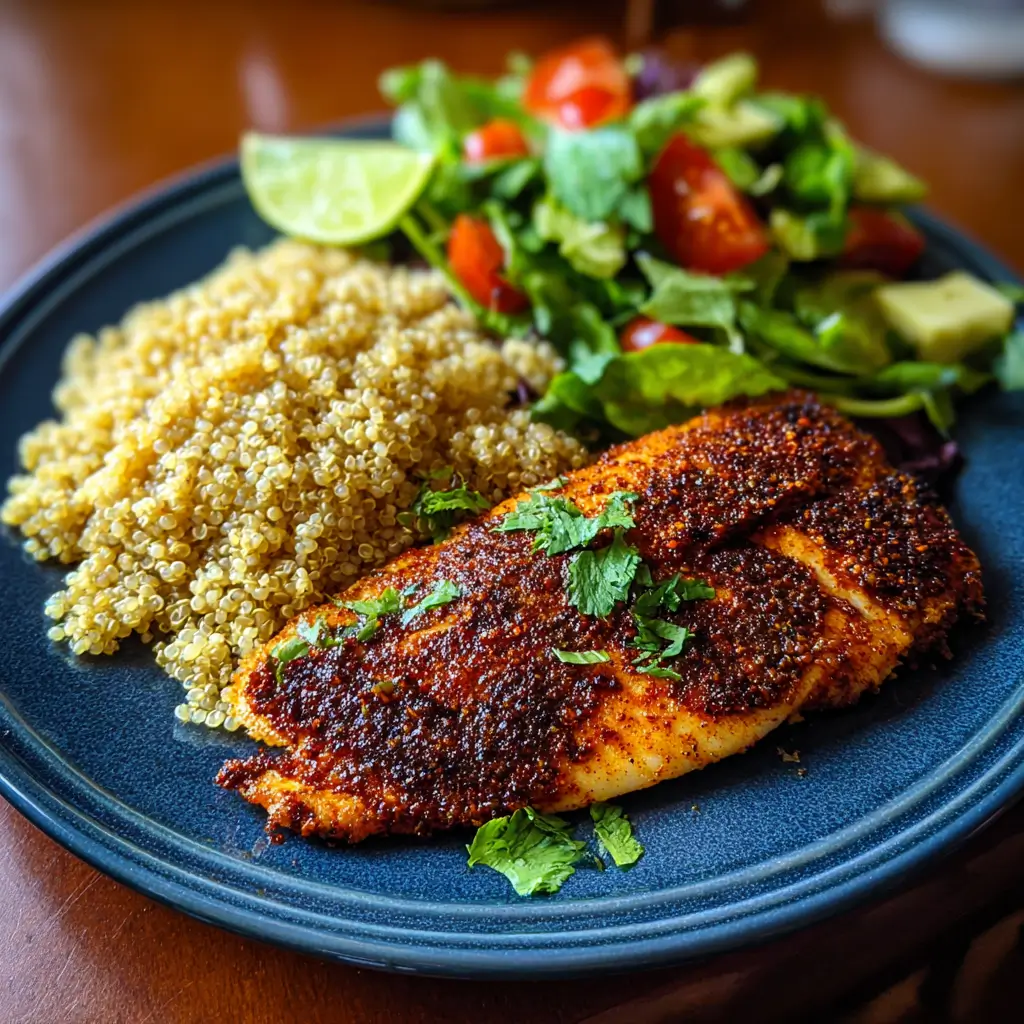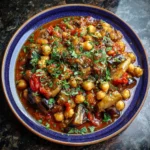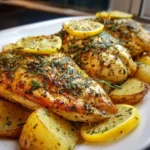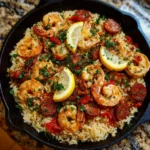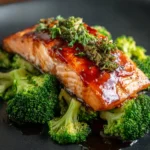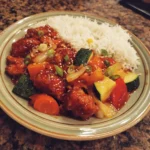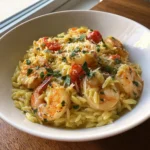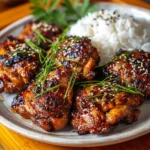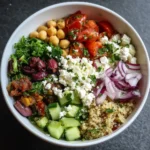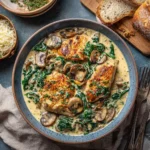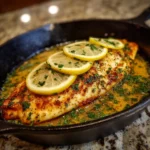Introduction
Cajun Blackened Tilapia with Quinoa is a vibrant, flavorful, and health-conscious dish that brings together the bold spices of Southern Louisiana cuisine with the wholesome nutrition of whole grains. Perfect for weeknight dinners or elegant weekend meals, this recipe combines tender, flaky tilapia fillets seasoned with a fiery blend of Cajun spices and seared to perfection, served atop a bed of fluffy, nutty quinoa. With its rich layers of flavor, ease of preparation, and balanced macronutrients, this meal has become a favorite among home cooks and health enthusiasts alike. Whether you’re exploring Creole cooking for the first time or seeking a quick, nutritious entrée, Cajun Blackened Tilapia with Quinoa delivers on every front—taste, texture, and nourishment.
The History
The roots of blackened fish trace back to the culinary traditions of Louisiana, particularly within Creole and Cajun cultures. The technique was popularized in the 1980s by renowned New Orleans chef Paul Prudhomme, who transformed a rustic method into a national sensation. Originally developed as a way to cook fish over open flames using cast-iron skillets, blackening involves coating proteins—most commonly redfish or catfish—with a robust mixture of spices and herbs, then searing them at high heat to form a dark, flavorful crust. While traditional recipes often used butter-heavy preparations, modern adaptations like this Cajun Blackened Tilapia reflect a lighter approach without sacrificing depth of flavor. Tilapia, though not native to Louisiana, has gained popularity due to its mild taste, affordability, and sustainability. Paired with quinoa—an ancient Andean grain celebrated for its complete protein profile—this dish bridges cultural heritage with contemporary wellness ideals, making it a symbol of fusion cuisine that honors tradition while embracing global ingredients and dietary awareness.
Ingredients Breakdown
The success of Cajun Blackened Tilapia with Quinoa lies in the careful selection and balance of its components. Each ingredient plays a pivotal role in building flavor, texture, and nutritional value. Let’s break them down:
- Tilapia Fillets: A mild, white-fleshed fish that absorbs spices beautifully and cooks quickly. It’s low in fat and calories but provides a good source of lean protein.
- Cajun Seasoning Blend: This is the soul of the dish. Typically includes paprika (for color and mild sweetness), cayenne pepper (for heat), garlic powder, onion powder, dried thyme, oregano, black pepper, and sometimes mustard powder. Some blends include salt, though low-sodium versions are available.
- Smoked Paprika: Adds a deeper, smoky dimension that complements the charred effect of blackening.
- Garlic and Onion Powder: Provide consistent savory notes without the texture of fresh alliums, ensuring even spice distribution.
- Fresh Lemon Juice: Brightens the dish, cuts through the richness of the spices, and enhances the fish’s natural flavor.
- Olive Oil or Avocado Oil: High smoke-point oils ideal for high-heat searing. They help create the signature crust without burning the spices.
- Uncooked Quinoa: A gluten-free seed rich in protein, fiber, iron, magnesium, and all nine essential amino acids. Rinsed before cooking to remove saponins, which can impart bitterness.
- Vegetable or Chicken Broth: Used instead of water to cook quinoa, adding subtle depth and enhancing overall savoriness.
- Butter or Vegan Butter (optional): For finishing the fish or enriching the quinoa, adding a silky mouthfeel and rounding out sharp flavors.
- Fresh Herbs (Parsley, Green Onions, or Cilantro): Added at the end for freshness, color, and aromatic lift.
- Lime Wedges (for serving): Offer an additional citrus zing that elevates the entire plate.
Optional enhancements may include diced tomatoes, bell peppers, or avocado slices for garnish, contributing both visual appeal and added nutrients.
Step-by-Step Recipe
- Prepare the Quinoa: Rinse 1 cup of quinoa under cold running water using a fine-mesh strainer to remove any bitter saponin coating. In a medium saucepan, combine the rinsed quinoa with 2 cups of vegetable or chicken broth. Bring to a boil, then reduce heat to low, cover, and simmer for 15 minutes or until liquid is absorbed and quinoa is fluffy with a slight curl in the germ. Remove from heat, fluff with a fork, cover, and let it rest for 5 minutes. Stir in a tablespoon of olive oil and season lightly with salt and pepper if desired.
- Make the Cajun Spice Blend (if not using store-bought): In a small bowl, mix together 1 tablespoon smoked paprika, 1 teaspoon garlic powder, 1 teaspoon onion powder, 1 teaspoon dried thyme, 1 teaspoon dried oregano, ½ teaspoon cayenne pepper (adjust for heat preference), ½ teaspoon freshly ground black pepper, and ½ teaspoon sea salt (optional). Set aside.
- Prepare the Tilapia: Pat 4 tilapia fillets dry with paper towels—this is crucial for achieving a proper sear. Place the fillets on a clean surface and brush both sides lightly with olive oil or avocado oil. Evenly sprinkle the Cajun seasoning on both sides, pressing gently to adhere. Allow the seasoned fish to sit at room temperature for 10–15 minutes to absorb the flavors.
- Heat the Skillet: Place a heavy-bottomed cast-iron skillet or non-stick pan over medium-high heat. Warm 1–2 tablespoons of oil until shimmering and just beginning to smoke. Proper preheating ensures the blackened crust forms quickly without overcooking the fish.
- Sear the Fish: Carefully place the seasoned tilapia fillets into the hot skillet. Do not overcrowd the pan; cook in batches if necessary. Sear for 3–4 minutes per side, depending on thickness, until the exterior is deeply browned (almost blackened) and the interior is opaque and flakes easily with a fork. Avoid moving the fillets too early to allow the crust to develop.
- Finish with Citrus: As the fish finishes cooking, squeeze fresh lemon or lime juice over each fillet. Optionally, add a small pat of butter to the pan and tilt to baste the fish for extra richness.
- Rest and Serve: Remove the fish from the skillet and let it rest for 2–3 minutes. Meanwhile, re-fluff the quinoa and adjust seasoning if needed. Spoon a generous portion of quinoa onto each plate, top with a blackened tilapia fillet, and garnish with chopped fresh parsley, green onions, or cilantro. Serve immediately with extra lime wedges on the side.
Tips
- Dry the Fish Thoroughly: Moisture is the enemy of searing. Always pat tilapia dry before seasoning to ensure a crisp, blackened crust rather than steaming.
- Use a Cast-Iron Skillet: Its superior heat retention is ideal for achieving the authentic blackened effect. Preheat it well before adding the fish.
- Don’t Overcrowd the Pan: Cooking too many fillets at once lowers the pan temperature and leads to soggy results. Cook in batches if needed.
- Control the Smoke: Blackening produces smoke. Turn on your exhaust fan, open windows, or consider cooking near a vent. Using an outdoor grill or griddle can also minimize indoor smoke.
- Adjust Spice Level: Cayenne can be reduced or omitted for milder palates. Conversely, add a pinch of crushed red pepper flakes for more heat.
- Season Ahead: Letting the fish sit with spices for 10–15 minutes enhances flavor penetration without drying out the delicate flesh.
- Quinoa Consistency: If your quinoa turns out mushy, try reducing the liquid slightly or avoid lifting the lid during cooking to prevent steam loss.
- Double the Batch: Make extra quinoa—it keeps well in the fridge for up to 5 days and can be used in salads, bowls, or breakfast porridge.
Variations and Customizations
This recipe is highly adaptable to suit different tastes, dietary needs, and pantry availability:
- Protein Swap: Replace tilapia with catfish, cod, salmon, or even chicken breasts for a heartier option. Adjust cooking times accordingly.
- Gluten-Free & Paleo-Friendly: Naturally gluten-free and easily adapted for paleo diets by omitting legumes and dairy, and ensuring the spice blend contains no fillers.
- Vegan Version: Use grilled portobello mushrooms or firm tofu slabs coated in the same Cajun rub for a plant-based alternative. Marinate tofu in lemon juice and oil beforehand for better flavor absorption.
- Grilled Option: Instead of pan-searing, grill the seasoned fish over high heat for a smokier taste and beautiful grill marks.
- Quinoa Alternatives: Substitute with brown rice, cauliflower rice, farro, or couscous depending on dietary preferences.
- Add Vegetables: Stir sautéed bell peppers, zucchini, corn, or spinach into the cooked quinoa for a complete one-bowl meal.
- Creamy Twist: Drizzle with a Cajun remoulade, garlic aioli, or avocado crema for added richness.
- Spice Blend Variations: Try Creole seasoning, Old Bay, or homemade blends with fennel seed, celery salt, or turmeric for unique flavor profiles.
Health Considerations and Nutritional Value
Cajun Blackened Tilapia with Quinoa is a nutritionally balanced meal that supports heart health, muscle maintenance, and sustained energy levels. Here’s a breakdown per serving (1 fillet + ¾ cup quinoa):
- Calories: Approximately 320–360 kcal
- Protein: 30–35g – High-quality protein from tilapia supports tissue repair and satiety.
- Carbohydrates: 30–35g – Mostly complex carbs from quinoa, providing slow-releasing energy and dietary fiber (around 5g per serving).
- Fat: 8–12g – Primarily healthy unsaturated fats from olive oil and minimal naturally occurring fat in tilapia.
- Omega-3 Fatty Acids: Moderate amounts in tilapia, especially if farm-raised on omega-3 enriched feed.
- Iron & Magnesium: Quinoa is a rich source of both, aiding oxygen transport and muscle function.
- B Vitamins: Present in both fish and quinoa, supporting metabolism and nervous system health.
- Sodium: Can vary significantly based on seasoning. To reduce sodium, use low-salt or homemade Cajun blends and unsalted broths.
Health Notes:
- Tilapia has been debated for its lower omega-3 content compared to fatty fish like salmon, but it remains a lean, accessible protein source when consumed as part of a varied diet.
- The spices used—especially cayenne and paprika—contain capsaicin and antioxidants linked to anti-inflammatory effects and improved circulation.
- Quinoa’s low glycemic index makes this meal suitable for individuals managing blood sugar levels, including those with type 2 diabetes.
- To enhance heart health, pair this dish with leafy greens or a side salad dressed in olive oil and vinegar.
Ingredients
- 4 tilapia fillets (about 6 oz each), skinless
- 2 tablespoons olive oil or avocado oil, divided
- 1 tablespoon smoked paprika
- 1 teaspoon garlic powder
- 1 teaspoon onion powder
- 1 teaspoon dried thyme
- 1 teaspoon dried oregano
- ½ teaspoon cayenne pepper (adjust to taste)
- ½ teaspoon freshly ground black pepper
- ½ teaspoon sea salt (optional)
- 1 cup uncooked quinoa (white, red, or tri-color)
- 2 cups low-sodium vegetable or chicken broth
- Juice of 1 lemon or lime
- 2 tablespoons fresh parsley or cilantro, chopped
- 2 green onions, thinly sliced (optional)
- Optional: 1 tablespoon butter or vegan butter
Directions
- In a small bowl, combine smoked paprika, garlic powder, onion powder, thyme, oregano, cayenne, black pepper, and salt. Mix well to create the Cajun seasoning blend.
- Pat tilapia fillets dry with paper towels. Brush both sides lightly with 1 tablespoon of oil, then season generously with the spice mix, pressing it into the fish. Set aside to marinate at room temperature for 10–15 minutes.
- Rinse quinoa under cold water in a fine-mesh strainer. In a medium saucepan, bring broth to a boil. Add quinoa, return to a boil, then reduce heat to low, cover, and simmer for 15 minutes or until liquid is absorbed. Remove from heat, let stand covered for 5 minutes, then fluff with a fork. Stir in ½ tablespoon oil and set aside.
- Heat remaining oil in a large cast-iron skillet or heavy pan over medium-high heat until very hot and slightly smoking.
- Carefully add the seasoned tilapia fillets. Sear for 3–4 minutes per side, until the exterior is deeply browned and fish is opaque throughout. Avoid flipping more than once.
- During the last minute of cooking, squeeze lemon or lime juice over the fillets. Optionally, add a pat of butter and tilt the pan to baste the fish.
- Remove fish from pan and let rest for 2–3 minutes. Re-fluff quinoa and season lightly if needed.
- Divide quinoa among four plates, top with a tilapia fillet, and garnish with fresh herbs and green onions. Serve immediately with extra citrus wedges on the side.
FAQ
Q: Is blackened fish actually burned?
A: No—the “blackened” appearance comes from a caramelized crust formed by spices searing at high heat. It’s not burnt, but deeply toasted, creating a complex, smoky flavor.
Q: Can I bake the fish instead of pan-searing?
A: Yes. Place seasoned fillets on a greased baking sheet and broil on high for 6–8 minutes, watching closely to prevent burning. The crust won’t be as intense but will still be flavorful.
Q: Is tilapia a sustainable choice?
A: It depends on sourcing. Look for tilapia certified by organizations like ASC (Aquaculture Stewardship Council) or labeled as responsibly farmed to ensure environmental and ethical standards.
Q: How do I store leftovers?
A: Store cooled fish and quinoa separately in airtight containers. Refrigerate for up to 3 days. Reheat quinoa with a splash of water; fish is best enjoyed cold in salads or gently warmed to avoid drying.
Q: Can I freeze this dish?
A: Quinoa freezes well for up to 3 months. Cooked tilapia can be frozen but may lose texture upon thawing. It’s better to freeze raw seasoned fillets or just the quinoa.
Q: Why is my quinoa bitter?
A: Likely due to saponins—a natural coating on quinoa seeds. Always rinse thoroughly under cold water before cooking to remove this soapy residue.
Q: What sides go well with this dish?
A: Steamed broccoli, sautéed greens, coleslaw, grilled vegetables, or a fresh tomato-cucumber salad complement the bold flavors beautifully.
Summary
Cajun Blackened Tilapia with Quinoa is a dynamic, nutrient-dense meal that fuses the fiery essence of Louisiana seasoning with the wholesome goodness of protein-rich quinoa. Quick to prepare yet impressive enough for guests, it offers a perfect harmony of bold flavor, satisfying texture, and clean nutrition.
